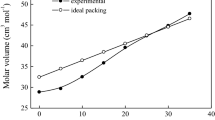Abstract
Composite materials prepared from barium boromolybdate glasses (MoO3content of 8, 12, or 16 wt %) and a cermet containing iron silicides were characterized by x-ray diffraction and resistivity measurements as a function of temperature. Increasing the content of the semicrystalline constituent first reduces the resistivity and then increases it to its original level. The minimum resistivity of the materials corresponds to a positive temperature coefficient of resistance. The results are interpreted in terms of the micro- and electric structures of the composites.
Similar content being viewed by others
REFERENCES
Kharitonov, E.V., Dielektricheskie materialy s neodnorodnoi strukturoi (Inhomogeneous-Structure Dielectric Materials), Moscow: Radio i Svyaz', 1983.
Hill, R., Electrical Transport in Thick Film Resistors, Electrocomp. Sci. Technol., 1980, vol. 6, no. 9, pp. 141–145.
Sachkov, I.N. and Povzner, A.A., Semiconductor-Metal Transition and Transport Behavior of FeSi-FeSi2 Mixed-Phase Systems, Fiz. Tverd. Tela (S.-Peterburg), 1996, vol. 38, no. 10, pp. 2969–2972.
Saifullin, R.S., Neorganicheskie kompozitsionnye materialy (Inorganic Composite Materials), Moscow: Khimiya, 1983.
Kachurina, E.E., Myakinenkov, V.I., and Shcheglova, V.V., Refractory Silicides in Semiconductor Technology, Part 2, Obz. Elektron. Tekh., Ser. 2: Poluprovodn Prib., 1982, no. 7 (903).
Vecherskii, S.I. and Sidorenko, F.A., Electrical Conductivity of Si-Doped Barium Boromolybdate Glass, Neorg. Mater., 1992, vol. 28, no. 7, pp. 1461–1465.
Gel'd, P.V. and Sidorenko, F.A., Silitsidy perekhodnykh metallov chetvertogo perioda (First-Row Transition-Metal Silicides), Moscow: Metallurgiya, 1971.
Rogers, D.B., Shannon, R.D., Sleight, A.W., and Gillson, J.L., Crystal Chemistry of Metal Dioxides with Rutile-Related Structures, Inorg. Chem., 1969, vol. 8, no. 4, pp. 841–849.
Vecherskii, S.I. and Sidorenko, F.A., Electrical Resistivity of FeSi2-MoO3-Glass Composites, Poroshk. Metall. (Kiev), 1991, no. 9, pp. 43–47.
Ambegaokar, V., Halperin, B., and Langer, J., Hopping Conductivity in Disordered Systems, Phys. Rev. B: Solid State, 1971, vol. 4, no. 8, pp. 2612–2620.
Rao, C.N.R. and Gopalakrishnan, J., New Directions in Solid State Chemistry: Structure, Synthesis, Properties, Reactivity, and Materials Design, Cambridge: Cambridge Univ. Press, 1986.
Samsonov, G.V., Dvorina, L.A., and Rud', B.M., Silitsidy (Silicides), Moscow: Metallurgiya, 1979.
Pike, G.E. and Seager, C.H., Electrical Properties and Conduction Mechanisms of Ru-Based Thick-Film (Cermet) Resistors, Appl. Phys., 1977, vol. 17, no. 48 (12), pp. 5152–5169.
Author information
Authors and Affiliations
Rights and permissions
About this article
Cite this article
Povzner, A.A., Vecherskii, S.I., Sidorenko, F.A. et al. Electrical Resistivity of Iron Silicide–Barium Boromolybdate Glass Composites. Inorganic Materials 37, 754–757 (2001). https://doi.org/10.1023/A:1017602929487
Issue Date:
DOI: https://doi.org/10.1023/A:1017602929487




